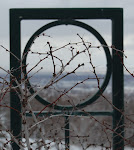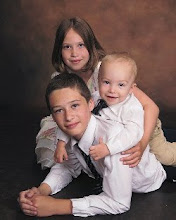Note: Scroll down for pictures of my throat before and after surgery as well as a photo of my nose before surgery.
This was the attitude- "Hurray for me"- that I had going into the operating room on May 15th. I can't be any farther away from that attitude than I am now, one week later (As of June 9th I'm three weeks post-op)after having the surgery. What a horrible, agonizing week I've had since then. And I've actually had no problems with infections or too much bleeding- but it was still the worst pain I've been in for such an extended period of time. I should start by going back to my reasons for electing to have this done to me.
Ever since my I started having problems with allergies as a young adult, I've been susceptible to sinus infections. I thought that nothing was worse than going through a sinus infection while pregnant and not being able to take anything other than antibiotics and Tylenol. Fast forward 10 years and yearly antibiotics for such infections and you end up with my first reason for getting my nose straightened and my tonsils out.
Oh, for those who may not know- I had a deviated septum (essentially a crooked part in my nose) in TWO different places. The surgery to correct such a problem is called Septoplasmy. It's a little difficult to explain how they repair such a thing, but you can click here and find out more or click here to see a drawing of a deviated septum. Having a deviated septum can cause your nasal passages on one side to become blocked or partly closed. This makes it difficult for your nose and sinuses to drain properly. It also makes it harder to breath since only one nostril is fully open. This adds to problems sleeping at night and snoring because the passages aren't open properly so you compensate by breathing through your mouth. Most people don't even know that they have such a problem because they have been coping with it for so long.
This photo is for the benefit of medical science and increasing the knowledge of others- but it sure is embarrassing for me to show to the people who know me. I know that others will be seeking out this type of photo as an example.
Pre-op photo of my deviated septum taken at home

Note: Post-op the nose is still misaligned from the outside, but I can feel the difference in the inside as I breath in. The nasal passage on my left on the inside is much more open. The procedure was done inside my nose with a few stitches on the inside that dissolved.
Now, go back about 4-5 years ago when my husband was having many weight, sleep apnea and heart problems. He was referred to many different specialists including an ENT which is an ear, nose and throat doctor. After he had seen this specialist and had a sleep study done, he was asked to use a CPAP machine at night. This is a contraption that has a mask to fit over your nose or mouth or both depending on what you breath through at night. then, humidified air is blown through it to create a "positive airflow". This means air is pumped through the mask which forces your body to breath it in more than it would without the continuous flow. Just a note- the air is not attached to an oxygen tank, it is just normal air with a little bit of humidity added so you don't get dried out. I hated the feeling when I tried his mask on and if you have problems with claustrophobia, you would hate it too!
Nevertheless, Ryan used this for a while before electing to have his tonsils and uvula as well as part of his soft palate removed. He really felt better after about a month of healing. He had more energy and was able to take better care of himself. He ended up losing over 40 lbs and has kept it off for a couple years now.
This is the same dilemma many people face- having a lot of weight to lose, but being too tired to exercise because your body is not getting the oxygen it needs at night to repair itself. People who have full-blown sleep apnea stop breathing for seconds at a time- sometimes it can be thirty seconds or more. Then their brain realizes this and they startle/wake up enough to breath again. This can be happening several times an hour. As a result, they wake up in the morning feeling worse than when they went to bed. Some people have headaches right as they wake up and others self-medicate by drinking caffeinated beverages to get some energy. Others over-indulge in carbohydrates because your body craves them when you are tired. Most people don't have energy to even think about getting some exercise, let alone get through the day without falling asleep. It really is a vicious cycle.
Now, I was seeing myself heading down that path and the momentum was picking up. I was waking up more tired and with my allergies, my passages were even more closed off and swollen. I had a bad sinus infection this spring and realized this wasn't getting any better for me. As we age, our skin becomes looser and so the back of the mouth doesn't regain it's shape that it had in our youth. This adds to snoring as there isn't much room for air to pass through. I had the wonderful joy of having an extra flap of skin in the back of my throat which adds to a smaller passage. Not only that, but little pockets would form in my tonsils and the flap and collect food particles in there that would harden over time. I couldn't do anything about it. I know it sounds gross, but luckily I didn't have bad breath like someone with halitosis might have. But those older food particles could have started infections eventually. There really was a reason why I needed to get my tonsils out!
WARNING: Pictures of the inside of my mouth!

Notice in the pre-op picture where the arrow is on your left. These pockets would trap food and get bigger. The food would harden and sometimes break loose and come out. Very gross!! The other arrow is showing my extra flaps of skin that would just take up room in my throat. They also added to snoring sounds like a sail flapping in the breeze....lol....
Also notice how swollen and red my throat is from allergies.
Next: Three weeks post-op.......

In the post-op picture you can see how much wider the back of my mouth is. The extra flaps are gone as well as the tonsils/pockets. I guess you can't see the area very well of where my tonsils used to be, but believe me, they aren't there! My throat is still red and scabs form where the skin was cauterized to stop the bleeding. I feel much better now and my husband hasn't noticed any snoring!
I hope those who read this appreciate the pictures because they are hard to get when your camera wants to focus on the closest thing which is my teeth or tongue. Even with a good camera (Nikon D40) and a second person taking the picture, it was really hard to get good photos.
For those wanting to know how my recovery went, I will be writing that up soon. That is another story in itself!
 Our flowers are blossoming so Ryan went out a couple of weeks ago and took these photos. I edited them (not much- he just hadn't got to them before I did) and I hope you enjoy them as much as we do! They put a smile on my face and every-so-often I can be found sniffing the flowers!
Our flowers are blossoming so Ryan went out a couple of weeks ago and took these photos. I edited them (not much- he just hadn't got to them before I did) and I hope you enjoy them as much as we do! They put a smile on my face and every-so-often I can be found sniffing the flowers!












.jpeg)

